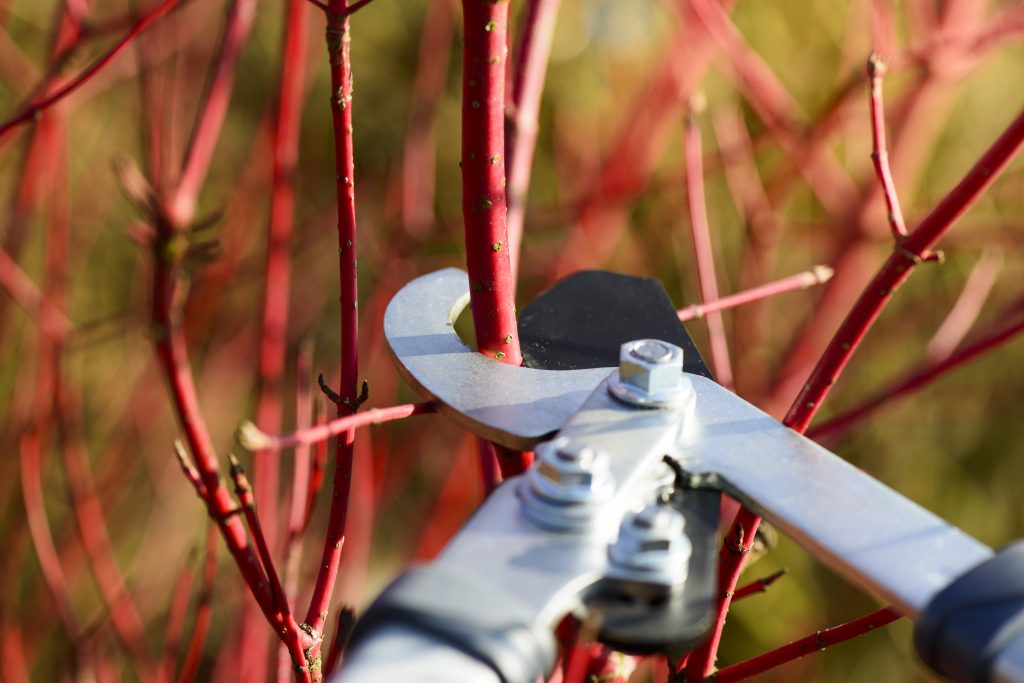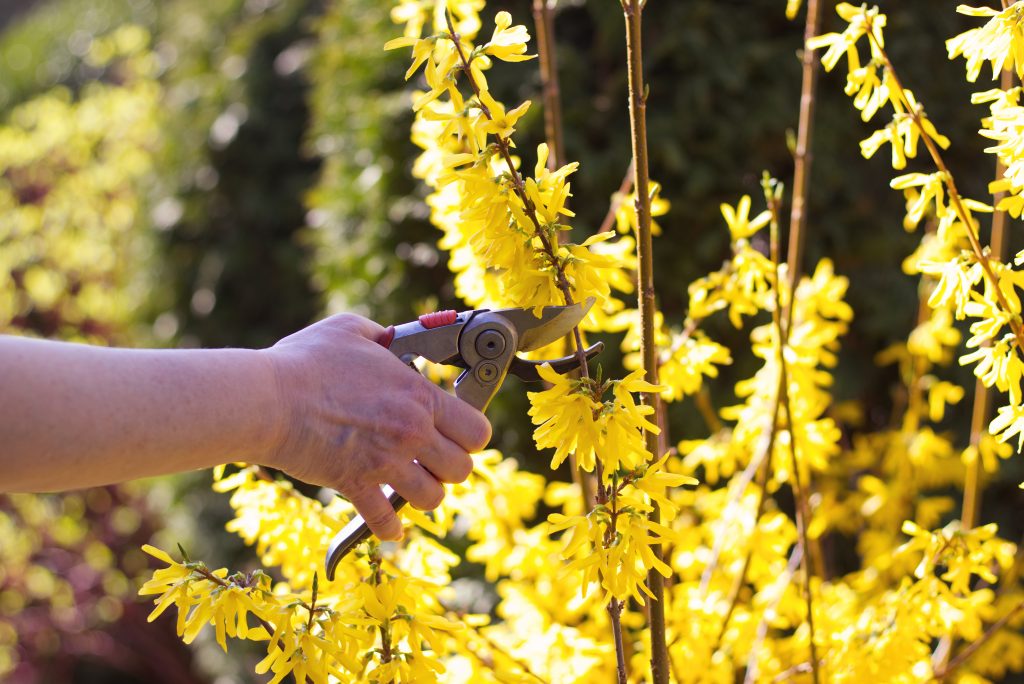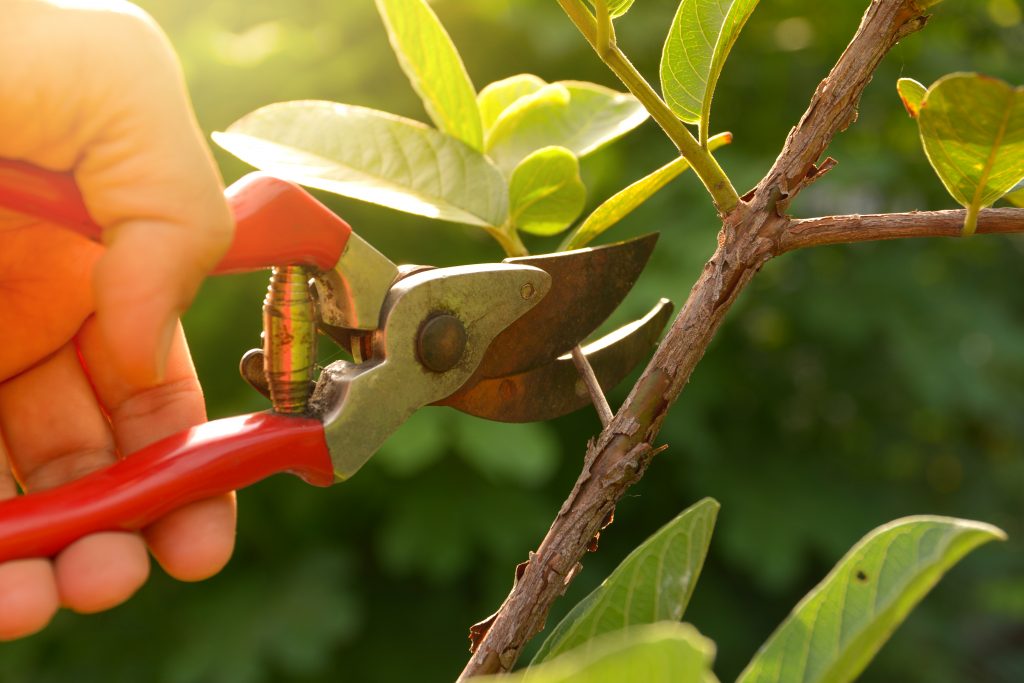
Pruning is an essential skill for the home gardener; however, many of us are apprehensive about pruning our trees and shrubs, fearing that we will do it incorrectly and cause long-term damage. Pruning is necessary for the health and maintenance of trees and shrubs and is a readily accessible skill for most homeowners. Remember, most plants are resilient and will eventually recover, even if we make a mistake.
Tools
The first step in pruning is to ensure that you have the proper tools. These are the most common tools for home use:
- Pruning shears are best for branches up to 1” in diameter.
- Bypass pruners make clean cuts that heal quickly.
- Anvil pruners can crush living tissue and are best reserved for use on dead wood.
- Loppers are similar to pruning shears but have long handles, thicker blades and are operated with both hands and can typically cut branches up to 2” in diameter.
- Pruning saws can be used on branches that are greater than 1” in diameter.
- Pole pruners are cutting blades attached to a telescoping pole and are designed to reach higher limbs.
- Hedge shears are used for shaping and contouring the outer shoots to develop a desired form that is not technically considered pruning.
- Make sure blades are clean and dry after each use.
- Sharpen and lubricate blades as needed. Sharp blades cut more easily and cause less crushing tissue damage. Crushed tissue is more likely to become a nidus of infection and disease.


Why Prune
Now that you have the appropriate tools, take a moment to consider the reasons that you might want to prune a particular plant. It makes no sense to simply get out and cut unless there’s a reason to do it, so before beginning to prune it’s important to decide the result you would like to achieve. Have a game plan before you start cutting!
- Maintain or improve plant health by eliminating dead or damaged wood.
- Removing older stems encourages a plant to put energy into new growth, thus keep the plant vigorous.
- Improve air circulation and light penetration to maintain health.
- Create or preserve structure.
- Increase bloom or fruit production.
- Enhance ornamental characteristics.
- Maintain plant size. Remember, plants will continue to grow despite pruning, so consider whether removing and replacing the plant is more practical especially if you are trying to limit the size. Breeders have been coming out with more varieties that are compact or have a smaller growth habit.
How to make your cuts:
- When pruning trees and shrubs, make an angled cut, approximately 45 degrees, just above and sloping away from a viable bud.
- In time, the bud develops into a branch, so when trying to develop growth on your plant, it is wise to prune above the bud that is pointing in the direction of desired growth.
- Prune side branches of trees at an angle, just outside the branch collar (i.e., avoid flush cuts).
- When pruning larger branches, remove smaller sections first in order to take the weight off of the branch and thus minimize the risk of splitting.

What to Prune:
- Dead, diseased or broken branches – cut about 6 inches below the problem area into healthy wood. Be sure to sterilize blades after each cut with a dilute bleach solution or ethanol or isopropyl alcohol to prevent spread of disease or pathogens.
- Branches that are rubbing together, crossing branches and branches with weak crotches should be pruned.
- Shrubs:
- Thin shrubs that have become too dense. Many deciduous shrubs benefit from regular maintenance pruning. Different growing habits require different approaches:
- Cane form shrubs – remove old canes that have decreased bloom production and very young stems. Both can be cut at the base. This will allow more light into the interior of the plant, prompting new growth.
- Mounding shrubs -prune the longest branches from inside the shrub mass to reduce height and volume.
- Tree-like shrubs- prune to open up center of the shrub, maximizing light penetration into the interior of the plant.
- Renewal pruning, where up to 1/3 of the oldest stems are removed at the base of the shrub, is a great way to rejuvenate tired older plantings that may not be performing up to expectations. Remember that most spring blooming shrubs flower on last season’s growth, which means that serious pruning in late winter or early spring will decrease the amount of flowering this season as any buds present on older wood are also removed.
- All deciduous shrubs can take a hard or heavy pruning in order to reduce size. Early spring is the best time to do this, and recovery is typically within two growing seasons. Please be aware by doing this any flowering potential would be removed for that season and possibly more until the plant recovers with more new growth.
- Thin shrubs that have become too dense. Many deciduous shrubs benefit from regular maintenance pruning. Different growing habits require different approaches:
- Trees:
- Suckers are young stems sprouting from the base or from a spot on the trunk of a tree. Cut them as close to their growing point as possible. Sucker Punch by Bonide is helpful in preventing further sucker and waterspout development.
- Sometimes people want to prune in order to dramatically reduce the size of a needled or broad-leaf evergreen. You can do it, but recovery could be anywhere from 3 to 5 years and the plant will tend to grow back to the original size again. It may be better to remove and replace with a plant suitable for the location.
- Avoid pruning the top of a tree. If this is your only alternative be aware that you have removed the apical dominance of the plant. This will trigger growth hormones will cause the plant to grow wider rather than taller, losing the natural shape of the plant. Also, over time the plant may try to develop new leaders that could compete, and you will then need to keep the strongest leader and prune off the others.
- Do not use wound dressing after pruning as they often seal in moisture and decay. In most cases, it is best to simply let wounds heal on their own.
- Tree branches that endanger property or interfere with overhead wires or nearby structures should be removed. These situations are often best left to a certified arborist.
- It is best to leave the pruning of large trees to a certified arborist.
When to Prune:
- Some basic principles apply that help simplify the pruning process for flowering shrubs:
- Early-blooming shrubs tend to set flowers on last year’s growth; these should be pruned as soon as their flowering finishes. Some examples are Hamamelis, Forsythia, Andromeda, Lilac, Fothergilla, Weigela, Azalea, Rhododendron, Kalmia, and Hydrangea macrophylla, quercifolia, and serrata.
- Shrubs that bloom later than spring usually form flowers on their current year’s new growth; these are best pruned before new growth begins in early spring, or in late fall/winter when they are dormant. Some of these are roses, Buddleia, Clethra, Potentilla, Hibiscus, Hydrangea paniculata and arborescens, and Spiraea.
- If you are in doubt, please consult with one of our garden center experts.
- For the home orchard, late winter and very early spring has always been considered an optimal time to prune fruit trees.
- Pruning deciduous trees and shrubs in late winter/early spring is easier to do, mostly because shape and structure are much easier to assess. It is also a better time to locate and remove a plant’s dead, diseased, and weak or damaged branch structure. Crossing branches and water sprouts can be quickly identified. Major pruning at this time is less stressful to the plant and there is less potential for spreading disease for susceptible hosts.
- New growth on most needled evergreen trees and shrubs is referred to as candles. As these candles are unfurling in early spring you can tip off them by ½ to 1/3. If you missed pruning at the candle stage, the next opportunity would be in July, pruning only the current growth or as far back as the previous year’s new growth. You shouldn’t prune in the fall as the older growth could be exposed to the upcoming cold winter weather which may damage the plant.







